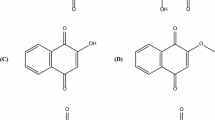Summary
β-(Isoxazolin-5-on-2-yl)-alanine (βIA), a heterocyclic non-protein amino acid from root extracts and root exudates of pea seedlings, acts as a potent growth inhibitor of several eukaryotic organisms, including yeasts, phytopathogenic fungi, unicellular green algae, and higher plants. The antibiotic effect on baker's yeast was reversed by l-methionine, l-cysteine, and l-homocysteine. Phytopathogenic fungi such as Botrytis cinerea, Pythium ultimum, and Rhizoctonia solani grown on agar containing βIA were inhibited in the growth of mycelia or in the production of sclerotia. In contrast, no significant inhibition of either Gram-positive or Gram-negative bacteria was observed. Rhizobium leguminosarum, the compatible microsymbiont of Pisum spp., and Rhizobium meliloti were able to tolerate up to 2.9 mM βIA (500 ppm) without any effect on the growth rate. Bradyrhizobium japonicum even gave a positive chemotactic response to βIA. The ecological significance of βIA as a preformed plant protectant during the seedling stage of Pisum spp. and other βIA-containing legumes is discussed.
Similar content being viewed by others
References
Atkin CL, Neilands JB, Phaff HJ (1970) Rhodotorulic acid from species of Leucosporidium, Rhodosporidium, Rhodotorula, Sporidiobolus, and Sporobolomyces, and a new alanine-containing ferrichrome from Cryptococcus melibiosum. J Bacteriol 103:722–733
Bell EA (1976) ‘Uncommon’ amino acids in plants. FEBS Lett 64:29–35
Bujard H, Gentz R, Lanzer M, Stueber D, Mueller M, Ibrahimi I, Haeuptle MT, Dobberstein B (1987) A T5 promotor-based transcription-translation system for the analysis of proteins in vitro and in vivo. In: Wu R (ed) Methods in enzymology, vol 155, part F. Academic Press, London, pp 416–433
Burden RS, Cooke DT, Carter GA (1989) Inhibitors of sterol biosynthesis and growth in plants and fungi. Phytochemistry 28:1791–1804
Hawkes TR, Howard JL, Pontin SE (1989) Herbicides that inhibit the biosynthesis of branched chain amino acids. In: Dodge AD (ed) Herbicides and plant metabolism. Cambridge University Press, Cambridge, pp 113–136
Ikegami F, Lambein F, Kuo YH, Murakoshi I (1984) Isoxazolin-5-one derivatives in Lathyrus odoratus during development and growth. Phytochemistry 23:1567–1569
Kape R, Parniske M, Werner D (1991) Chemotaxis and nod gene activity of Bradyrhizobium japonicum in response to hydroxycinnamic acids and isoflavonoids. Appl Environ Microbiol (in press)
Knight TJ, Durbin RD, Langston-Unkefer PJ (1987) Self-protection of Pseudomonas syringae pv. “tabaci” from its toxin, tabtoxinine-β-lactam. J Bacteriol 169:1954–1959
Kohno T, Kohda D, Haruki M, Yokoyama S, Miyazawa T (1990) Non-protein amino acid furanomycin, unlike isoleucine in chemical structure, is changed to isoleucine tRNA by isoleucyl-tRNA synthetase and incorporated into protein. J Biol Chem 265:6931–6935
Krotzky A, Werner D (1987) Nitrogen fixation in Pseudomonas stutzeri. Arch Microbiol 147:48–57
Kuo YH, Lambein F, Ikegami F, Van Parijs R (1982) Isoxazolin-5-ones and amino acids in root exudates of pea and sweet pea seedlings. Plant Physiol 70:1283–1289
Lambein F, Kuo YH, Van Parijs R (1976) Isoxazolin-5-ones: Chemistry and biology of a new class of plant products. Heterocycles 4:567–593
Lambein F, Kuo YH, Ikegami F, Murakoshi I (1990a) Toxic and nontoxic nonprotein amino acids in the Vicieae. In: Lubec G, Rosenthal GA (eds) Amino acids: Chemistry, biology and medicine. Escom, Leiden, pp 21–28
Lambein F, Ongena G, Kuo YH (1990b) Beta-isoxazolinone-alanine is involved in the biosynthesis of β-N-oxalyl-L-α,β-diaminopropionic acid, the neurotoxin responsible for human lathyrism. Phytochemistry 29:3793–3796
Lowry OH, Rosebrough MJ, Farr AL, Randall RJ (1951) Protein measurement with the Folin phenol reagent. J Biol Chem 193:265–275
Meister A (1985) Glutamate synthase from Escherichia coli, Klebsiella aerogenens, and Saccharomyces cerevisiae. In: Meister A (ed) Methods in enzymology, vol 113, Academic Press, London, pp 327–337
Nomoto K, Sugiura Y, Takagi S (1987) Mugineic acids, studies on phytosiderophores. In: Winckelmann G, Van der Helm D, Neilands JB (eds) Iron transport in microbes, plants and animals. VCH Verlagsgesellschaft, Weinheim, pp 401–425
O'Brien P, Nunn PB (1982) Metal ion complexes of amino acids. Part II [1]. The copper complexes of the α- and β-isomers of N-oxalyl-L-α,β-diaminopropionic acid. Inorg Chim Acta 66:185–188
O'Neal D, Joy KW (1973) Glutamine synthetase of pea leaves. I. Purification, stabilization and pH optima. Arch Biochem Biophys 159:113–122
Paul EA, Clark FE (1989) Soil microbiology and biochemistry. Academic Press, San Diego
Röhm M, Jacobsen E, Werner D (1989) Lack of root hair proteins in nodulation deficient and supernodulating pea mutants. Endocytobiosis Cell Res 6:75–86
Schenk SU, Werner D (1991) β-(3-Isoxazolin-5-on-2-yl)-alanine from Pisum: Allelopathic properties and antimycotic bioassay. Phytochemistry (in press)
Schönbeck F, Grunewaldt-Stöcker G (1986) Preformed antimicrobial compounds in relation to disease resistance. In: Gould GW, Rhodes-Roberts ME, Charnley AK, Cooper RM, Board RG (eds) Natural antimicrobial systems. Part I. FEMS Symp 35, Bath University Press, Bath, pp 176–190
Senger H, Bishop NI (1972) The development of structure and function in chloroplasts of greening mutants of Scenedesmus I. Formation of chlorophyll. Plant Cell Physiol 13:633–649
Van Egeraat AWSM (1978) Root exudates of pea seedlings and their effect upon Rhizobium leguminosarum. In: Loutit MW, Miles JAR (eds) Proceedings in Life Sciences: Microbial Ecology. Springer, Berlin Heidelberg New York, pp 384–389
Werner D, Wilcockson J, Zimmermann E (1975) Adsorption and selection of rhizobia with ion exchange papers. Arch Microbiol 105:27–32
Author information
Authors and Affiliations
Rights and permissions
About this article
Cite this article
Schenk, S.U., Lambein, F. & Werner, D. Broad antifungal activity of β-isoxazolinonyl-alanine, a non-protein amino acid from roots of pea (Pisum sativum L.) seedlings. Biol Fertil Soils 11, 203–209 (1991). https://doi.org/10.1007/BF00335768
Received:
Issue Date:
DOI: https://doi.org/10.1007/BF00335768




